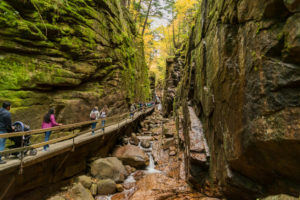
White Mountains Hiking
ASCEND TO NEW HEIGHTS
 Connect with Nature
Connect with Nature
Put one foot in front of the other as you explore some of the most beautiful terrain in New England. Once you complete the challenge of ascending the landscape, you’ll be rewarded with awe-inspiring views of nature. You should always hike with someone, know your limits, tell someone where you are going, and be prepared for rapid weather changes.
Popular walking and White Mountains hiking trails near Jackson Village include:
Rt. 16A Loop – The village stroll takes you from the covered bridge, past inns and shops, crossing the Wildcat River and continuing past the Wentworth Golf Course before coming out at Route 16.
Jackson Falls – This is a popular spot to picnic as you hike past a series of cascades and small waterfalls, on a sidewalk running along the road. Go up the left side of the brook on Carter Notch Road.
Carter Notch Road and Route 16B – The complete loop stretches five and a half miles, starting above Jackson Falls. You pass Eagle Mountain Resort and back down to the falls.
North Doublehead – This trail winds through the woods once you park at Route 16B to Dundee Road, taking you to the saddle between North and South Doublehead. The trail is about four miles and takes you up 1,800 feet to an elevation of 3,053 feet.
Hall’s Ledge and the Carter Notch Area – From the end of Carter Notch Road there are various hiking trails. Hall’s Ledge is a fine hike on wide cross-country ski trails to a small clearing with views north to Mount Washington. Five miles roundtrip, so allow a couple of hours at least.
Diana’s Bath – An easy 0.5 mile walk, Diana’s Bath takes you to cascading waterfalls, waterspouts, and granite basins along Lucy Brook. Click here to to view our blog about nearby hiking at Diana’s Baths!
Black Cap – Just before reaching the scenic Rt. 16, turn east on Hurricane Mountain Road. Here you will find a 2.5 mile trail that leads you through spruce forests all the way to the bare summit with views of Saco River valley along the way.
Glen Ellis Falls – A shorter trail, Glen Ellis Falls is a 0.4 mile trail located near Mt. Washington. The entire trail takes about 15 minutes to complete. You might even encounter other people while exploring!
Crystal Cascade – Considered to be an easier trail, Crystal Cascade takes about 20 minutes and spans roughly 0.75 miles. You know you’ll be getting close when you start hearing a large waterfall!
Lowe’s Bald Spot – This popular hiking trail is considered to be a moderately challenging route. It spans roughly 4 miles and can take about 2 hours to complete. Start from the Visitor Center, then take the Old Jackson Road Trail towards the Mt. Washington Auto Road. Once crossed, the Madison Gulf Trail will lead you to Lowe’s Bald Spot where you will have scenic views of Mt. Washington.
Glen Boulder Trail – A challenging route, Glen Boulder Trail is about 5.5 miles long and can take upwards of 5 hours to complete. This constant uphill battle is ideal for those who enjoy backpacking, camping, and tough hiking.
Raymond Path Loop – This popular trail for walking and hiking is about 4.5 miles long and can take about 2.5 hours to complete. This trail takes you through forests all the way to the Tuckerman Ravine Trail.
Find more tips on White Mountains hiking and great spots to check out in our blog, and happy hiking in the Mt. Washington Valley!
White Mountains Hiking FAQs
- How many trails are in the White Mountains?
The White Mountains National Forest plays host to 218 hard trails ranging in length from 2.6 to 136.5 miles, and from 462 to 6,286 feet above sea level. - What is the hardest hike in the White Mountains?
The Huntington Ravine Trail is considered the most difficult hiking trail in the White Mountains area. Located on the east face of Mt. Washington, Huntington Ravine is a steep, bowl-shaped valley called a glacial cirque. - What should you bring hiking in the White Mountains?
The gear you’ll need on a hiking excursion is dependent on factors like season and weather, as well as the planned duration of the trip, but some things to consider include: proper footwear, backpack or daypack, proper clothing, a hat and sunscreen, insect repellent, water and snacks, hiking poles, a map, compass, or GPS, and a hiking buddy. - Is Mt. Washington a difficult hike?
The summit to Mt. Washington is actually considered one of the most dangerous hikes in the world and is also a rewarding feat. Just over eight miles round-trip, this hike doesn’t come without its challenges. - What are the best White Mountains hikes for beginners?
There are plenty of hiking trails in the White Mountains that are ideal for beginners, some of which include: Mount Willard, Lonesome Lake, Artist’s Bluff, Arethusa Falls Trail, and Mount Pemigewasset. - What White Mountains hikes are ideal for day trips?
Some hikes in the White Mountains that are great for day trips include Franconia Ridge, Arethusa Falls, Baldface Mountain Loop, Mount Chocorua, Artist’s Bluff Trail, and Mount Willard. - What waterfalls can you hike to in the White Mountains?
White Mountains hiking offers up many trail options that include the amazing reward of waterfall views. Some of these trails include Basin-Cascades Trail, Arethusa Falls, Rainbow Falls, Diana’s Baths, Nancy Cascades, Falling Waters Trail, Flume Gorge, Ripley Falls, Bridal Veil Falls, and more. - When is the best time to go hiking in the White Mountains?
White Mountains hiking is a popular activity year-round. That said, each season has its special challenges and rewards, so it’s important to be prepared. - Can you hike in the White Mountains in winter?
You can certainly hike in the White Mountains during the winter season, but it will be critical to be prepared. You’ll likely encounter several feet of snow, strong winds, and below-zero temperatures, but the area also offers up unmatched beauty and panoramic views that make the effort worthwhile. - Do you need snowshoes for winter hiking?
If your hiking trip takes you to higher elevations with heavier snowfall, snowshoes will be a critical piece of gear for you. When you’re moving through deep, powdery snow, hiking boots and spikes will not be sufficient to keep you from sinking into snow as deep as your waist. - Are there a lot of swimming holes in the White Mountains?
There are many swimming holes to explore in the summer months on your White Mountains hiking adventures. Some great swimming spots to check out include Livermore Falls State Forest on the Pemigewasset River, Sawyer Rock at Crawford Notch, the Smith Covered Bridge on the Baker River, Diana’s Baths, and the Swiftwater Covered Bridge on the Ammonoosuc River. - Are dogs allowed in the White Mountains National Forest?
Yes, dogs are allowed in the White Mountains National Forest. That said if you do choose to bring your dog hiking with you, you must carry a leash and ensure your dog is properly restrained when in trailhead parking lots, developed campgrounds, and other developed site areas. Before you visit specific areas, be sure to do your research to make sure dogs are allowed there specifically.







